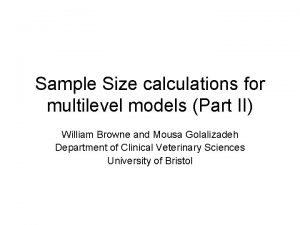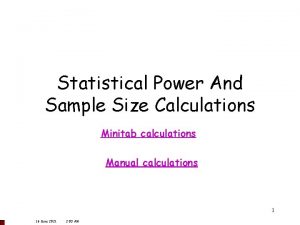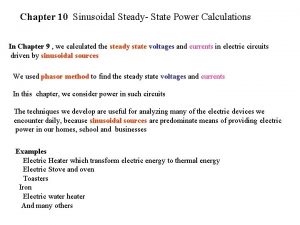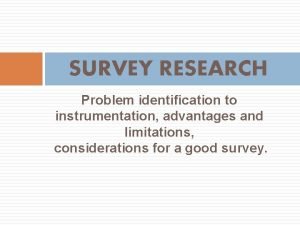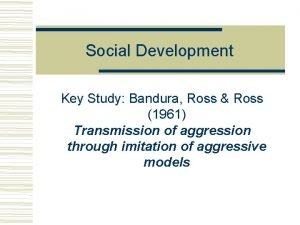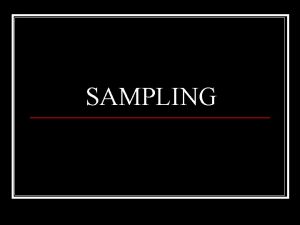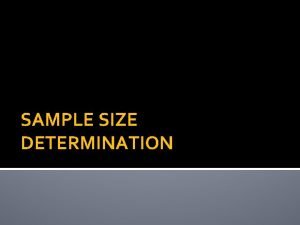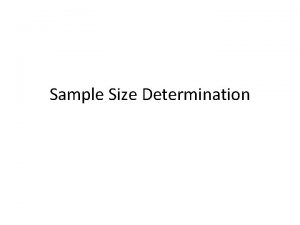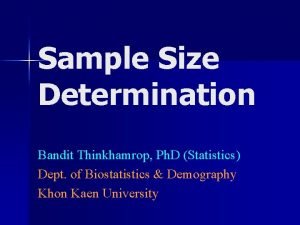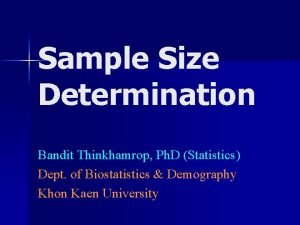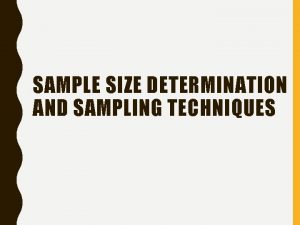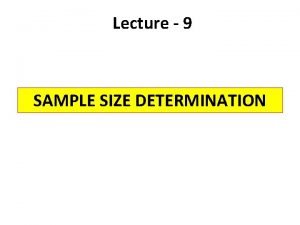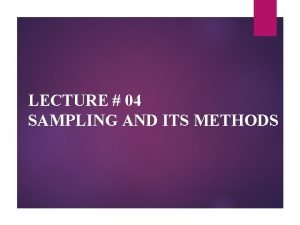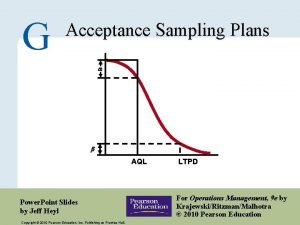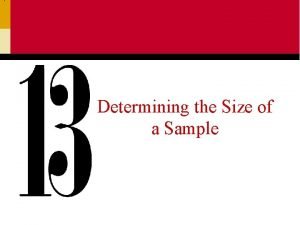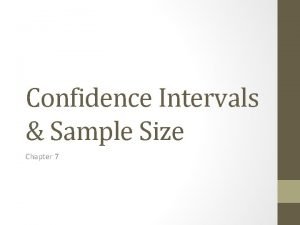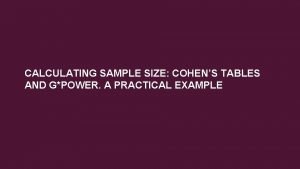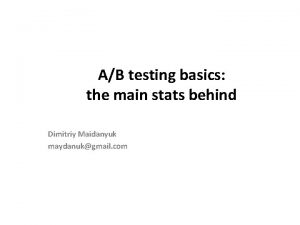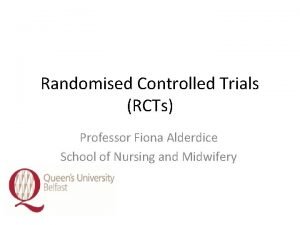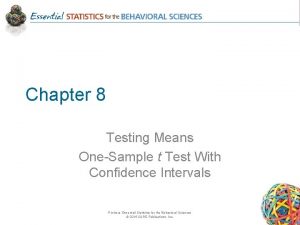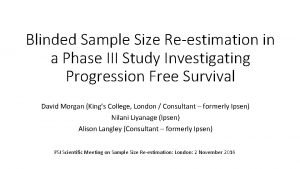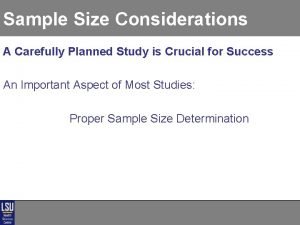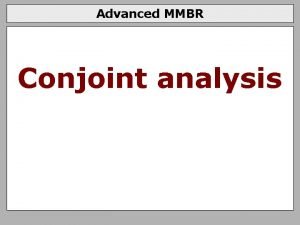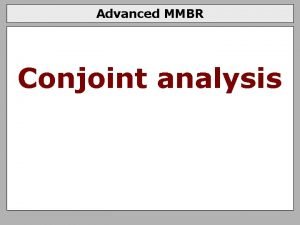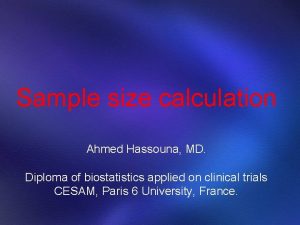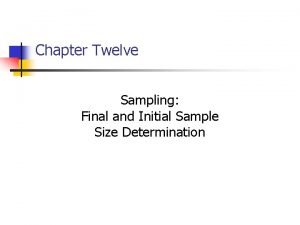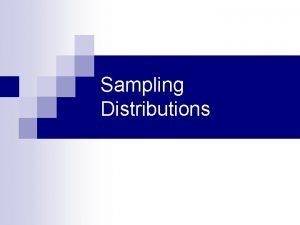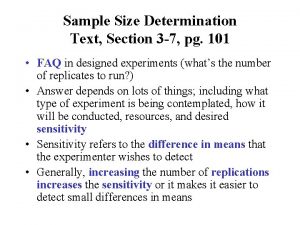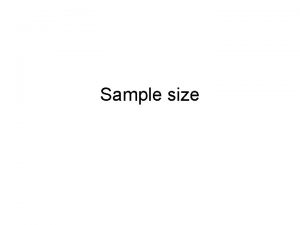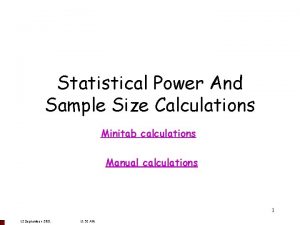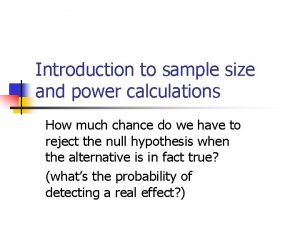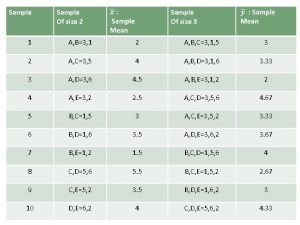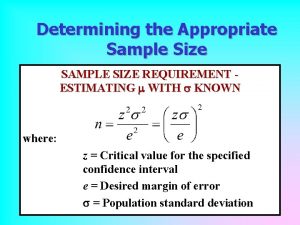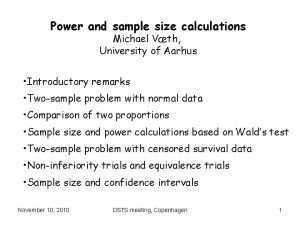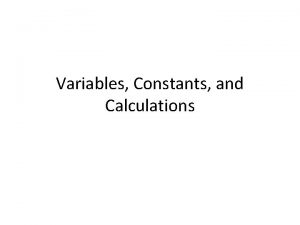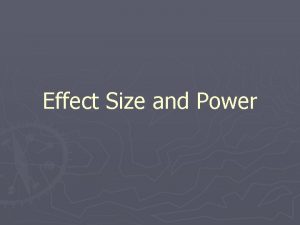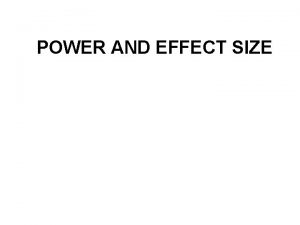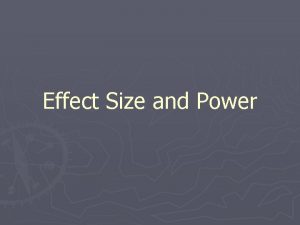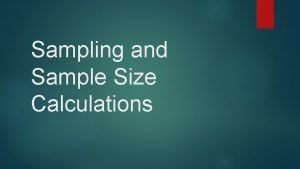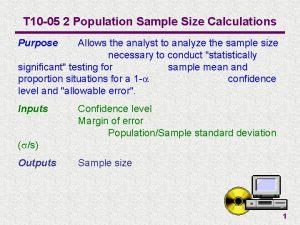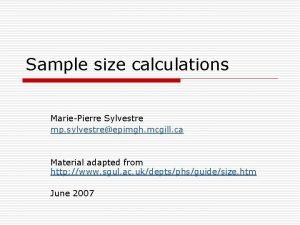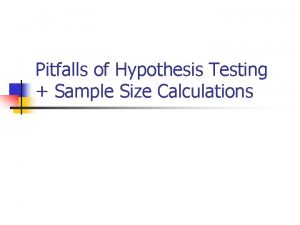Introduction to sample size and power calculations How











































- Slides: 43

Introduction to sample size and power calculations How much chance do we have to reject the null hypothesis when the alternative is in fact true? (what’s the probability of detecting a real effect? )

Can we quantify how much power we have for given sample sizes?

study 1: 263 cases, 1241 controls Null Distribution: difference=0. Rejection region. Any value >= 6. 5 (0+3. 3*1. 96) For 5% significance level, one-tail area=2. 5% (Z /2 = 1. 96) Power= chance of being in the Clinically relevant rejection region if the alternative: is true=area to the right of this difference=10%. line (in yellow)

study 1: 263 cases, 1241 controls Rejection region. Any value >= 6. 5 (0+3. 3*1. 96) Power here: Power= chance of being in the rejection region if the alternative is true=area to the right of this line (in yellow)

study 1: 50 cases, 50 controls Critical value= 0+10*1. 96=20 Z /2=1. 96 2. 5% area Power closer to 15% now.

Study 2: 18 treated, 72 controls, STD DEV = 2 Critical value= 0+0. 52*1. 96 = 1 Clinically relevant alternative: difference=4 points Power is nearly 100%!

Study 2: 18 treated, 72 controls, STD DEV=10 Critical value= 0+2. 58*1. 96 = 5 Power is about 40%

Study 2: 18 treated, 72 controls, effect size=1. 0 Critical value= 0+0. 52*1. 96 = 1 Power is about 50% Clinically relevant alternative: difference=1 point

Factors Affecting Power 1. 2. 3. 4. Size of the effect Standard deviation of the characteristic Bigger sample size Significance level desired

1. Bigger difference from the null mean Null Clinically relevant alternative average weight from samples of 100

2. Bigger standard deviation average weight from samples of 100

3. Bigger Sample Size average weight from samples of 100

4. Higher significance level Rejection region. average weight from samples of 100

Sample size calculations n n Based on these elements, you can write a formal mathematical equation that relates power, sample size, effect size, standard deviation, and significance level… **WE WILL DERIVE THESE FORMULAS FORMALLY SHORTLY**

Simple formula for difference in means Sample size in each group (assumes equal sized groups) Standard deviation of the outcome variable Represents the desired power (typically. 84 for 80% power). Effect Size (the difference in Represents the desired level of statistical significance (typically 1. 96).

Simple formula for difference in proportions Represents the desired power (typically. 84 for 80% power). Sample size in each group (assumes equal sized groups) A measure of variability (similar to standard deviation) Effect Size (the difference in proportions) Represents the desired level of statistical significance (typically 1. 96).

Derivation of sample size formula….

Study 2: 18 treated, 72 controls, effect size=1. 0 Critical value= 0+. 52*1. 96=1 Power close to 50%

SAMPLE SIZE AND POWER FORMULAS Critical value= 0+standard error (difference)*Z /2 Power= area to right of Z =

Power= area to right of Z = Power is the area to the right of Z. OR power is the area to the left of - Z. Since normal charts give us the area to the left by convention, we need to use - Z to get the correct value. Most textbooks just call this “Z ”; I’ll use the term Zpower to avoid confusion.

All-purpose power formula…

Derivation of a sample size formula… Sample size is embedded in the standard error….

Algebra…


Sample size formula for difference in means

Examples n Example 1: You want to calculate how much power you will have to see a difference of 3. 0 IQ points between two groups: 30 male doctors and 30 female doctors. If you expect the standard deviation to be about 10 on an IQ test for both groups, then the standard error for the difference will be about: = 2. 57

Power formula… P(Z≤ -. 79) =. 21; only 21% power to see a difference of 3 IQ points.

n Example 2: How many people would you need to sample in each group to achieve power of 80% (corresponds to Z =. 84) 174/group; 348 altogether

Sample Size needed for comparing two proportions: Example: I am going to run a case-control study to determine if pancreatic cancer is linked to drinking coffee. If I want 80% power to detect a 10% difference in the proportion of coffee drinkers among cases vs. controls (if coffee drinking and pancreatic cancer are linked, we would expect that a higher proportion of cases would be coffee drinkers than controls), how many cases and controls should I sample? About half the population drinks coffee.

Derivation of a sample size formula: The standard error of the difference of two proportions is:

Derivation of a sample size formula: Here, if we assume equal sample size and that, under the null hypothesis proportions of coffee drinkers is. 5 in both cases and controls, then s. e. (diff)=


For 80% power… There is 80% area to the left of a Z-score of. 84 on a standard normal curve; therefore, there is 80% area to the right of -. 84. Would take 392 cases and 392 controls to have 80% power! Total=784

Question 2: How many total cases and controls would I have to sample to get 80% power for the same study, if I sample 2 controls for every case? n Ask yourself, what changes here?

Different size groups… Need: 294 cases and 2 x 294=588 controls. 882 total. Note: you get the best power for the lowest sample size if you keep both groups equal (882 > 784). You would only want to make groups unequal if there was an obvious difference in the cost or ease of collecting data on one group. E. g. , cases of pancreatic cancer are rare and take time to find.

General sample size formula

General sample size needs when outcome is binary:

Compare with when outcome is continuous:

Question n How many subjects would we need to sample to have 80% power to detect an average increase in MCAT biology score of 1 point, if the average change without instruction (just due to chance) is plus or minus 3 points (=standard deviation of change)?

Standard error here=

Where D=change from test 1 to test 2. (difference) Therefore, need: (9)(1. 96+. 84)2/1 = 70 people total

Sample size for paired data:

Paired data difference in proportion: sample size:
 Sample size calculations in multilevel modelling
Sample size calculations in multilevel modelling Structural steel connection calculations calculations
Structural steel connection calculations calculations Power analysis minitab
Power analysis minitab Real power and reactive power
Real power and reactive power Steady state current formula
Steady state current formula Chapter 7 confidence intervals and sample size
Chapter 7 confidence intervals and sample size Char char slide
Char char slide Why size separation is required
Why size separation is required What is a survey research method
What is a survey research method Bandura sample size
Bandura sample size What is the sample size in qualitative research?
What is the sample size in qualitative research? Typical case sampling
Typical case sampling Factors affecting sample size
Factors affecting sample size Paired t-test formula
Paired t-test formula Formula for sample size
Formula for sample size Sample size formula
Sample size formula Morgan formula for sample size
Morgan formula for sample size Yamane formula for sample size
Yamane formula for sample size What is the sample size in qualitative research?
What is the sample size in qualitative research? Paired t-test formula
Paired t-test formula Sampling formula
Sampling formula Oc curve table
Oc curve table How to define sample size
How to define sample size Sudhakar patra
Sudhakar patra One sample z interval formula
One sample z interval formula Confidence interval formula sample mean
Confidence interval formula sample mean Statistical treatment
Statistical treatment Effect size calculation
Effect size calculation Optimizely calculator
Optimizely calculator Fiona alderdice
Fiona alderdice Sample size ratio mismatch
Sample size ratio mismatch Effect size for t-test
Effect size for t-test Blinded sample size re-estimation
Blinded sample size re-estimation Sample size
Sample size Conjoint analysis sample size rule of thumb
Conjoint analysis sample size rule of thumb Conjoint analysis sample size rule of thumb
Conjoint analysis sample size rule of thumb Surveymonkey sample size
Surveymonkey sample size Harvard sample size calculator
Harvard sample size calculator Cohen 1992 sample size table
Cohen 1992 sample size table Sample size
Sample size Initial sample size
Initial sample size Sample size symbol
Sample size symbol Sample size determination
Sample size determination Sampling process
Sampling process
